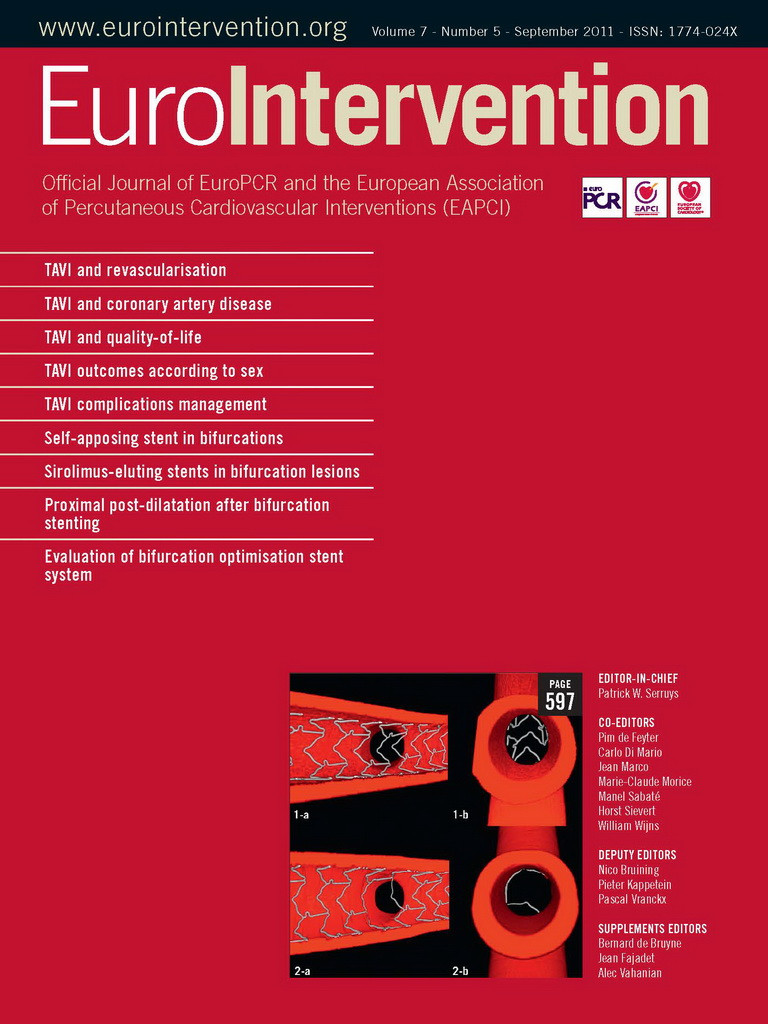Aortic valve stenosis (AS) is the major valvular heart disease in the western countries. Despite excellent surgical results of conventional aortic valve replacement, transcatheter aortic valve implantation (TAVI) has been accepted and widely used in selected high-risk patients with promising results1,2. Since AS and coronary artery disease (CAD) share similar pathophysiological pathways, AS coincides with significant CAD in many TAVI candidates3. Additionally, the increased risk of morbidity and mortality for patients with AS and concomitant CAD has to be reflected by surgeons and interventionalists before TAVI4.
In the current issue, Gautier and colleagues analysed the impact of CAD on decision making and outcome in TAVI candidates with concomitant CAD.5 More than 50% of the 240 patients referred for TAVI had CAD with primarily advanced stages of disease. Most of the patients have already been treated either with PCI or CABG before TAVI. Surprisingly CAD was firstly detected during TAVI evaluation in almost one-third of the patients, whereas the necessity to treat CAD by PCI was limited to only eleven (17%) patients. Despite the higher risk profile of patients with AS and concomitant CAD, the mortality rate at 30 days and follow-up of 248±239 days did not differ respectively.
In the study by Wenaweser and Pilgrim, almost two-thirds of the 256 patients had CAD6. In contrast to Gautier et al, 35% of the patients received CAD treatment by PCI, 23 patients as staged and 36 patients as concomitant procedure. The DUKE jeopardy score to assess myocardium at risk and the SYNTAX score were used to guide CAD treatment strategy via PCI. There was no significant difference with regard to the VARC safety endpoints between the TAVI and the TAVI+PCI group, as well as for the staged and concomitant approach. It has to be underlined that all cause mortality in the PCI group was almost double compared to the TAVI group (10.2% vs. 5.6%) without reaching the level of significance, most likely due to the limited patient number. In this paper, the low rates of significant renal failure stage 3 according to the RIFLE criteria is noticeable given the relatively high amounts of contrast medium used in all groups. Even if the SYNTAX score was comparable, 330±140 mL of contrast medium were used only for PCI in the staged intervention group. It appears that more complex procedures were possibly performed at two different time points. Another interpretation might be the operator-dependent cautious use of contrast medium during a concomitant approach.
Comparing both papers, risk profiles using the EuroSCORE were basically equal, but STS scores were higher in the paper by Gautier et al. This possibly reflects different patient populations or different weighting of the variables. Additionally, the different PCI rates prior or during TAVI has to be noted (11% vs. 35%), whereas the occurrence of concomitant CAD was comparable in both papers (63% vs. 65%). Thus we can hypothesise that judgement of CAD severity and the indication for revascularisation differed significantly. Standardised evaluation of CAD using FFR has been shown to be superior to only angiographically guided PCI7. Haemodynamic characterisation using FFR, evaluation of myocardium at risk, suitability of the target lesion for the interventional approach and symptoms of the patient should be reflected. In case of significant disease, all treatment options should be discussed in a multidisciplinary heart team. Thus, in case of a large area at risk and high SYNTAX scores, surgical treatment using conventional AVR and CABG might be considered as a treatment option. Vice versa, the current articles underline that an interventional approach using PCI has been shown to be an alternative in the TAVI cohort with concomitant CAD without significant impact on short-term outcome.
The staged or concomitant approach can be considered, but patient characteristics, classic risk factors of morbidity and mortality is additional to clinical judgement as well as frailty, which have to be taken carefully into account. The available data do not support one or the other strategy due to the lack of randomised trials in larger cohorts.8 However, staged procedures have obvious advantages: contrast media is given at two separate time points, thus its clearance is supported, especially in patients with impaired renal function. High imaging quality and shorter procedural times of these single steps are an advantage too. The equity of the two approaches regarding the over all VARC safety endpoint is mainly driven by the high rates of access related complications as well as the occurrence of relevant bleeding events in the staged PCI group as reported by Wenaweser et al6. However, bleeding events and access site complications are mostly driven by technical issues. Proper access evaluation, closure device use, awareness and immediate management of complications, can help to deal with this remaining topic as partly addressed by Hildick-Smith et al in the current issue9.
In summary, we are gaining (still limited) evidence that CAD and severe AS can be effectively treated –even in high-risk patients– with reasonable results using the percutaneous approach. However, all treatment options as well as the necessity of revascularisation and strategies to achieve sufficient myocardial perfusion results should be discussed openly and individually for every patient in a multidisciplinary heart team.
Conflict of interest statement
The authors have no conflict of interest to declare.
References




